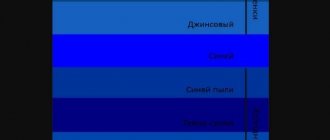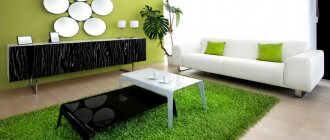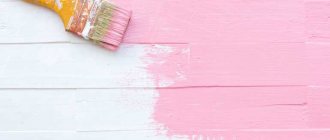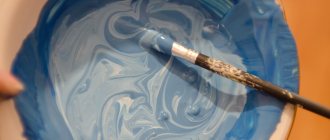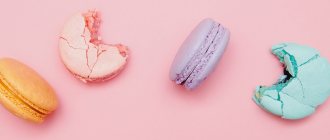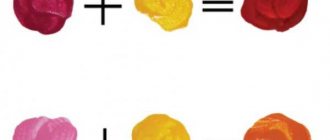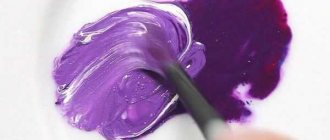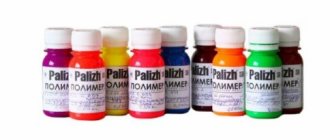Every person who has ever held a brush and paint in his hand knows that you can get a lot of shades from two or three colors. The rules for mixing and matching colors are determined by the science of coloristics. Its basis is the color wheel known to many. There are only three primary colors: red, blue and yellow. Other shades are obtained by mixing and are called secondary shades.
What colors of paint should be mixed to get brown?
Brown is considered complex; when creating it, you can use all the primary colors. There are several ways to get brown:
- Classic: green + red in proportions 50:50.
- The main trio: blue + yellow + red in equal quantities.
- Mixing: blue + orange or gray + orange. You can vary the intensity of the hue by adding less or more gray.
- Optional: green + purple + orange. This shade has a pleasant red or red tint. You can also mix yellow + purple - the color will have a yellowish tint.
| Combination | Proportions | Resulting shade |
| Green + red | 1:1 | Brown |
| Blue + orange Gray + orange | 1:1 | Tan |
| Yellow + purple | 0,8:1 | Tan |
| Red + yellow + blue | 2:2:0,5 | Red-brown |
| Light brown + indigo (black) | 1:1 | Chocolate |
| Green + purple + orange | 1:0,8:1 | Red-brown |
What colors of paint need to be mixed to get purple?
The easiest way to get purple is to mix equal proportions of red and blue. True, the shade will turn out a bit dirty, and it will need to be adjusted.
To make the tone cooler, take 2 parts blue and 1 part red and vice versa.
To achieve lavender and lilac, the resulting dirty purple needs to be diluted with white. The more white, the lighter and softer the shade.
Dark purple can be obtained by gradually adding black or green to the original color.
| Combination | Proportions | Resulting shade |
| Red + blue | 1:1 | Basic purple |
| Basic purple + white | 1:1 | Lilac, lavender |
| Basic purple + black | 1:0,5 | Dark purple |
| Red + yellow + blue | 1:0,5:1 | Purple |
| Basic purple + red | 1:1 | Red-violet |
What colors should you buy?
Tinting is the name of the science that studies mixing styles and obtaining the desired shade. It is this science that helps to obtain lilac color, as well as fuchsia, ivory, sea wave or sea when mixing colors. In theory, to create many colors, it is enough to have yellow, red and blue. But in this case, you can get a narrow spectrum.
To create a wide palette, it is enough to buy the following colors:
- Red;
- Yellow;
- Brown;
- Pink;
- Blue;
- Black;
- White.
These colors are quite sufficient for applying the basic scales. Gold, silver, mother-of-pearl and other additional colors are also used for artistic decoration of drawings.
Paint mixing table
What colors of paint need to be mixed to get red?
Red is considered a base color and is present in any artistic palette. However, you can get red by mixing violet (magenta) and yellow in a 1:1 ratio. You can also mix a carmine shade with yellow to create a more intense red. You can make it lighter by adding more yellow and vice versa. Shades of red can be obtained by adding orange, pink, yellow, and white to the base red.
| Combination | Proportions | Resulting shade |
| Magenta + yellow | 1:1 | Basic red |
| Magenta + yellow | 2:1 | Burgundy |
| Carmine + yellow | 1:1 | Rich red |
| Basic red + yellow | 2:1 | Scarlet |
| Basic red + pink (white) | 2:1 | Pink-red (adjust saturation with auxiliary color) |
Color mixing options to create shades of gray
The tone that is obtained by combining white with black is considered classic. The finished color can be changed as follows:
- introduce a drop of blue or green, making it cold, pearlescent,
- add yellow or ocher to get a warm ash color,
- make a duet of mouse and antimony to create a metallic shade,
- combine gray with pink to create a beautiful ash pink, dusty color.
If you add red to black and white, you will get an interesting copper-gray tone. Also, an unusual ash color is prepared by combining yellow, white, and violet - this combination also ultimately gives an achromatic shade. When mixing watercolors, gray comes from the duo of blue and brown. The scope for imagination is quite rich, and many experiments ultimately make it possible to produce the shade the artist needs!
What colors of paint should be mixed to get beige?
Beige color is a neutral and independent color; it has many shades, which can be achieved by varying the amount of white and yellow shades added.
The easiest way to get beige is to mix brown and white.
To make the color more contrasting, you can add a little yellow.
Flesh beige can be obtained by mixing scarlet, blue, yellow and white. The ivory shade is created by mixing golden ocher and white paint.
| Combination | Proportions | Resulting shade |
| Brown + white | 1:3 | Beige |
| Scarlet + yellow + white + blue | 1:1:2:0,5 | Nude beige |
| Golden ocher + white | 1:2 | Ivory |
Types of green color and their production
There are approximately 15 main tones of green (ranging from pale to blue-green).
In addition to these, there are more than 100 shades, which are somewhat similar to the main one, but at the same time have certain differences.
So, to make a cooler shade, you need to add a little blue; artists like to use this tone to create winter paintings.
But if you add yellow, then the shade turns out to be very warm, spring and joyful.
Pale greens
The pastel palette of greenery looks very soft, beautiful, and is often used when creating apartment design, also in public places (clinics, children's institutions, schools, and so on).
Pale greens have a calming effect, bring harmony and help fight stress, great for children's rooms.
It’s easy to get this tone - just add white paint to regular green.
Or mix yellow and green in equal proportions, and then add white until the desired pigment is obtained.
Olive color
This tone is called luxurious and noble; interior designers love it very much.
This shade is called the color of olive fruits (yellow-green darkened pigment). Getting it yourself is quite problematic.
To do this, you need to drip yellow very little at a time, and to add darkness, add a little brown.
Bottle glass color
This is also considered a dark shade of the third row. The base is blue and yellow, but more yellowish is used.
After the material is mixed, a little more black is added. Its exact quantity can only be determined in practice.
If you add too much, the color will turn out ugly, dirty, and even a white tone will not help. Different specialists can add blue, then the color will turn out to have a blue tint.
Needle color
It can be obtained in this way: just a little yellow is added to ordinary green, and then a drop of black pigment.
The result will be the same shade that is used to create New Year's themed paintings.
And if you add a little white, you get pine needles in the fog, which is also popular when creating drawings.
green fern
Not all varieties of greenery may be familiar to a person who is not associated with art, but experts know them well.
To get the color of fern, just a little black is added to ordinary greenery, then white is added.
This is such a smoothly transitioning color scheme between light and dark tones. This option is widely used by professionals for painting houses and walls, for creating banners and billboards.
Green forest
In order to get shades of natural greenery, take regular green and add a little yellow pigment.
If you need to make dark greens. Then a drop of black paint will help.
This tone is well suited for the interior of an apartment, as well as in the fight against depression.
Light green
Light green is obtained by mixing the classic shade with yellow and white.
It is very bright and cheerful, you can often see clothes for children in this shade, and only individual parts are in the design.
This tone looks beautiful and unusual together with pink (found in toys).
Designers of clothes for adults use this color to create a bright and extravagant look in clothes.
If you add yellow to it, then you can get a lemon tint.
Swamp tone
It is also called khaki tone, which can be created by mixing greens, browns and a little red.
It is very practical and has good camouflage functions, which is why the military uniform is of this color.
In room design it is used to create a calm atmosphere, and in clothing to achieve a military direction.
Dark greens
To make the green darker and deeper, you need to introduce a black or brown tone, it depends on how much you need to darken it.
Everyone chooses the required amount independently, because a large amount looks quite gloomy.
That is why it is used in small quantities in design.
As you can see, there is a large amount of green. The main thing is not to be afraid to mix and obtain a variety of shades, and then you will be able to create the most unusual and beautiful work of art.
What colors of paint need to be mixed to get green?
Green color can be achieved by mixing yellow and blue in equal parts. The result will be a grassy green hue. If you add white color to it, the mixture will lighten. By mixing brown or black pigment, you can achieve emerald, marsh, olive, dark green shades.
| Combination | Proportions | Resulting shade |
| Blue + yellow | 1:1 | grassy green |
| Blue + yellow + white | 1:1:0,5 | Light green, salad |
| Blue + yellow + black | 1:1:0,5 | Swamp, dark green |
| Yellow + blue + brown | 1:2:0,5 | Gray-green |
What colors of paint need to be mixed to get gray?
The classic tandem for getting gray is black + white. The more white, the lighter the finished shade.
- You can also mix red, green and white. The color will have a slight yellow tint.
- A blue-gray shade can be created by mixing orange with blue and white.
- If you mix yellow with purple and white, you get a gray-beige shade.
| Combination | Proportions | Resulting shade |
| White + black | 2:1 | Light gray |
| Red + green + white | 1:1:2 | Gray-yellow |
| Orange + blue + white | 1:1:2 | Gray-blue |
| Yellow + purple + white | 1:0,5:2 | Gray beige |
Producing color by mixing different pigments
So what tones are needed to make it green? First you need to study the circle of colors.
Green in various tones is between blue and yellow, which means that it is with the help of these colors that the pigment we need will be obtained.
If you take equal parts of these shades, you get classic green. And its other shades are obtained by changing the proportions of those tones.
What colors of paint need to be mixed to get black?
Black is a basic monochrome color. It can be obtained by mixing magenta with yellow and cyan. Also, artists often mix green and red, but the resulting shade will not be jet black. Rich black color is produced by a mixture of orange and blue and yellow and violet. To get the shade of the night sky, you can add a little blue to the finished color, and a drop of white to lighten it.
| Combination | Proportions | Resulting shade |
| Red + green | 1:1 | Dark brown, almost black |
| Magenta + yellow + cyan | 1:1:1 | Black |
| Blue + orange | 1,5:1 | Night sky |
| Orange + purple | 1:2 | Black |
General information
What tools will you need?
To complete the work you will need the following tools:
- Palette - ideally it should be white, because a colored surface can distort shades. Ideally, models made of plastic or other materials with similar properties are suitable.
- The main set of colors is blue, red, green, yellow, black and white.
- Brushes.
- A glass or even a small jar of water. The liquid should be changed from time to time to prevent the brushes from becoming clogged.
- A rough canvas – you can use it to check how well a brushstroke can go.
If you don’t have a palette, you can replace it with a glass, plate, bowl, special mixing bowl, or any other plastic/glass container. It is important that all tools are clean and free of previously used paints.
Getting Color
To get different shades of purple, including lilac, you should mix red and blue paint. It is important to avoid yellow and all shades that contain it, as otherwise the result will be a dirty brown or gray undertone. When mixing, it is important to pay attention to the degree of saturation and purity of the blue and red colors - the characteristics of the final color will depend on this. If the set of paints contains pure purple, then it is better to use it to create shades. The resulting shades will be more saturated and less pale than those created by mixing blue and red.
- Simple purple
The standard purple color can be obtained by mixing red and blue in a ratio of 1 to 2. Then, from this base, you should create various shades, add white, black, pink, blue and other tones.
- Light purple
It will be much easier to get a light purple color by adding white to the base color. For the main color, white should be gradually mixed until the desired result is achieved, and the result should be periodically checked on the palette. The maximum ratio of white to base will be 1 to 5, since otherwise the main color may be lost.
If you want to slightly lighten the tone, you can dilute the paint with purple water. This helps keep it more natural and rich. It is worth considering the fact that mixing light colors is allowed only on a snow-white palette, because a painted or wooden surface will distort everything. It is not difficult to get a lilac color by mixing paints, and you can also make a light shade (thistle, wisteria and lilac) by mixing pink and blue.
You should take the first color as a basis, and then gradually introduce the second. Cooler shades of pink will produce pale tones of light purple, while warmer shades can add brightness. If you add a little red to the color, you get a nice amethyst light color. By adding blue you can achieve bright undertones with a berry tint.
- Dark purple
A darkened shade is obtained by mixing dark blue and bright red. The first color will absorb the warmth and richness of the second, resulting in a dull eggplant shade. It can be made even a little brighter by increasing the amount of red, but this will not completely change the situation. An unusual option for a dark purple color would be mixing red and black paint. The second should be added carefully, in small drops, as otherwise the tone will be dirty. The brighter dark purple color is made from a mixture of indigo, red and lilac. The saturation and tonality will depend on the proportion of colors, and you can also select it at your discretion.
How to adjust color
The purple color palette has an incredible number of shades, and each of them is used for decoration or painting. To obtain the required tone, mix paints, and also make corrections.
Its rules are:
- White will help lighten the tone and move it towards pastels. Watercolor and other paints can be diluted with a small amount of water. But you should not overdo it with the liquid, as otherwise you can ruin the paper or even get unsightly watery stains on the canvas.
- Adding black helps to darken the violet, but it must be introduced carefully as otherwise the mixture will completely lose color and become dirty to a dark grey. You can avoid this by adding dark indigo color.
- You can get lavender and delicate shades by turning gray to purple.
- To make the color richer, you can add a small amount of warm pink color. By changing the proportions and concentration, you can get grape, amethyst and other shades.
- Once again mix purple and red, and you can also get dark tones, for example, berry, wine and eggplant.
- Darken the purple a little by adding indigo or blue. As a result, you will get a cool and rich shade that is suitable for painting a night landscape.
- To get a bright plum color, you need to take a dark purple and dilute it with pure red.
- By adding a little blue tone to the purple, it can be shifted towards the blue without additional darkening. Lighten the resulting color with white if delicate lilac undertones are required.
Please note that when correcting color, be sure to ensure the cleanliness of the brushes and working surface. The smallest particles of other paint can ruin the entire work, clogging the paint with gray or brown specks. To avoid this, instruments should be washed thoroughly after each use.
What colors of paint need to be mixed to get blue?
Blue is the main color in the palette and it is quite difficult to obtain it by mixing. It is believed that it can be obtained by adding a little yellow to green, but in practice the result is more of a blue-green tint. You can mix purple with blue, the shade will be deep but dark. You can lighten it by adding a drop of white.
| Combination | Proportions | Resulting shade |
| Yellow + green | 0,5:1 | Blue-green |
| Purple + blue | 1:1 | Blue |
| Purple + light blue + white | 1:1:1 | Light blue |
| Basic blue+ black | 3:1 | Dark blue, blue-black if you add more black |
What colors of paint need to be mixed to get yellow?
The basic yellow color cannot be achieved by mixing other shades. Something similar happens if you add green to orange. Variations of yellow are obtained by adding other tones to the basic one. For example, lemon is a mixture of yellow, green and white. Sunny yellow is a mixture of basic yellow, a drop of white and red.
| Combination | Proportions | Resulting shade |
| Orange + green | 1:1 | Dirty yellow |
| Basic yellow + green + white | 1:0,5:0,5 | Citric |
| Basic yellow + white + red | 4:1:1 | Sunny yellow |
What colors of paint need to be mixed to get pink?
The easiest option is to mix red and white. The more white, the lighter the shade. It is important to know that the tone depends on which red you choose:
- Scarlet + white will give a pure pink color.
- Brick red + white – peach pink.
- Blood red + violet give a fuchsia shade.
- Orange-pink can be obtained by adding yellow paint to scarlet and white.
| Combination | Proportions | Resulting shade |
| Scarlet + white | 1:2 | Pink |
| Brick red + white | 1:2 | Peach pink |
| Purple + blood red | 1:1 | Fuchsia |
| Scarlet + white + yellow | 1:2:1 | Orange pink |
Getting pink when working with different paints
First you need to decide exactly what is considered pink. The reference shade is the color of the petals of Rose Canina - this is a traditional rosehip that is widespread almost everywhere. The technology for creating the shade will depend on the type of paint used.
To get pink from watercolor, you need to take red and then dilute it with water until the desired shade appears. Depending on the desired saturation, add more or less water.
When gouache is used, the technology for creating color will change slightly. Take red paint and regular white. Then both materials are mixed on the palette - the result is pink. If you add more red to the resulting mixture, you will get a bright pink hue. With more white, the tint will become light pink.
It must be borne in mind that after drying the gouache becomes lighter than when wet.
To obtain a pink color when working with oil-based paints and varnishes, take “kraplak” paint and add white. Depending on the proportion of the two substances, the pink will be brighter or paler. When using acrylic paints, white is also used.
In the video: mixing colors and getting new ones.
What colors of paint need to be mixed to get orange?
Orange color can be obtained by mixing red and yellow.
- A less saturated shade will be obtained if pink pigment is added to yellow paint.
- Terracotta orange is the result of mixing base orange with blue or purple.
- Dark shades are achieved by mixing red, yellow and black.
- If you add brown instead of black, you get red orange.
We vary the intensity of the tone by adding more white or black.
| Combination | Proportions | Resulting shade |
| Red + yellow | 1:1 | Orange |
| Pink + yellow | 1:1 | Light orange |
| Red + yellow + purple | 1:1:0,5 | Terracotta |
| Red + yellow + black | 1:1:0,5 | Dark orange |
| Red + yellow + brown1 | 1:1:1 | Ginger |
Color Basics
Colorology teaches how to distinguish between different colors. How they can be mixed and combined, taking into account all the colors.
Even a beginner in drawing knows that mixing colors are divided into two groups: those that mix well and produce new colors. And those that give ugly shades.
To get a green tone, you need to buy primary colors (red, yellow and blue).
Also, to create its light and dark shades you will need black and white paint. By adding different amounts of these colors, you can get a variety of halftones.
